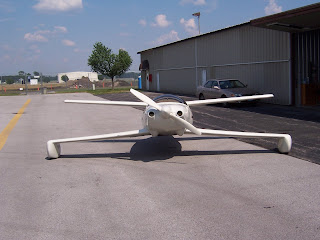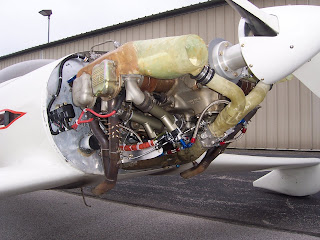Finally. Finally. I got it back in the air. I told Sandy that I flew and she said something like "Whew! O-boy". She sounded just like Walter Cronkite.
I didn't pick the date, it just happened, but my third first flight in the Quickie happily fell on the 40th anniversary of the moon landing. Heady stuff for all.
I always told Sandy, "I'll fly it when it's ready". The to-do list finally got whittled down so there was nothing left to do but fly. I haven't posted my recent struggles, like the primary system going dead for no apparent reason (I blew a critical fuse while tinkering) or the back-up system not working (I somehow had discharged the back-up battery down to 5 volts).
But today, all systems were go for launch and I committed aviation. Twice, in fact.
My good buddy C-Rod brought out his entire A&P inspections class witness the crime, in direct opposition to my general secrecy policy for these events. But It worked out - I just ignored them and went into my secret place. You know, where the Olympians go right before that big track or swimming event.
A parachute was offered, but it turned out there just wasn't room, so I didn't wear it.

It started just fine and I ran it up and down an inactive runway a few times and everything seemed strong. With my straightened tailspring and lengthened cowling, I have lost a fair amount of forward visibility while taxiing, but I'll get used to it.

So I went out to 18L and flew. Must have gotten all of three tenths before the oil really started getting hot and I told the tower I wanted back down.
I bounced the landing a bit, but cut me a break, it has been a year and a half since I flew this critter and all's well that ends well.
My residual adrenalin must have stayed with me for a couple of hours. There are lots of things to work on, trim and cooling, etc, etc., but they will sort out in time and I hope to be going fast again.
I have to make a mention here. On the way back from the airport I got a phone call from my good friend Jim Patillo, who was calling to tell me a Quickie builder, Ron Weiss, had been killed while flying another type of homebuilt (Lancair) out in California. I never met Ron but he did post messages often on the Quickie Builders e-mail list, and we sure hate it when we get those calls. I guess you could say it made today's event somewhat bittersweet.
But anyway, after I calmed down a few hours I went out and committed aviation a second time - I wanted to get a better handle on what my new Dynon instrumentation was telling me.
This time, the engine wasn't quite so hot and I was able to stay up for about four tenths of an hour.
That's enough for now, just remember, there is no higher education than aviation. And hey - Let's be safe out there.














